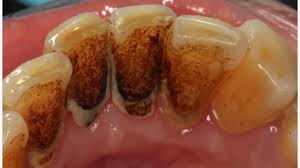The term "calculus bridge" might sound intimidating, but it’s an important concept in dental health that everyone should understand. A calculus bridge is a significant buildup of tartar (hardened plaque) that spans across multiple teeth, forming a continuous, bridge-like structure. This formation can lead to severe dental issues if not addressed promptly. In this article, we will explore the causes, symptoms, and treatments of the calculus bridge, providing a comprehensive guide to maintaining optimal oral health.
What is a Calculus Bridge
A calculus bridge, also known as tartar bridge, is essentially a large deposit of calculus that accumulates along the gum line and between teeth. Unlike plaque, which is a soft and sticky film of bacteria, calculus is hardened and can only be removed by a dental professional.
Causes of a Calculus Bridge
The primary cause of a calculus bridge is poor oral hygiene. Failing to brush and floss regularly allows plaque to accumulate on the teeth and gum line. When this plaque isn’t removed, it hardens into calculus. Certain factors can accelerate this process and contribute to the formation of a calculus bridge:
The Importance of Maintenance and Follow-Up
After treatment, maintaining good oral hygiene is crucial to prevent the recurrence of a calculus bridge. Follow your dentist's recommendations for at-home care and schedule regular checkups. Using an antibacterial mouthwash can help control bacteria and plaque. Additionally, consider using an electric toothbrush, which may be more effective at removing plaque than a manual toothbrush.
Complications of Untreated Calculus Bridges
Ignoring a calculus bridge can lead to several complications that affect both dental health and overall well-being. As the bridge of hardened tartar accumulates, it creates a conducive environment for bacteria to thrive. This can lead to advanced gum disease, also known as periodontitis, characterized by inflammation and infection of the gums. Periodontitis can cause irreversible damage to the gums, bones, and ligaments that support the teeth, potentially leading to tooth loss.
Addressing Fear and Anxiety Surrounding Dental Visits
Fear and anxiety about dental visits are common reasons why individuals may avoid seeking treatment for dental issues like a calculus bridge. However, delaying treatment can exacerbate oral health problems and lead to more invasive procedures in the future. Dentists understand these concerns and can work with patients to alleviate anxiety through patient education, communication, and the use of sedation techniques if necessary.
The Role of Patient Education and Awareness
Educating patients about oral health and the consequences of neglecting dental care is crucial in preventing calculus bridges. Dental professionals play a vital role in teaching patients proper brushing and flossing techniques, the importance of regular dental checkups, and the early signs of dental issues like plaque buildup.
Emerging Trends in Dental Technology and Treatment
Advancements in dental technology continue to improve the diagnosis, treatment, and prevention of calculus bridges. Digital imaging techniques such as intraoral scanners and cone-beam computed tomography (CBCT) provide detailed images of the teeth and gums, aiding in the early detection of calculus and other dental issues.
The Importance of Routine Dental Check-Ups
Regular dental check-ups are essential for maintaining optimal oral health and preventing dental issues such as calculus bridges. Dentists can detect early signs of plaque and calculus buildup during routine cleanings and exams. Professional cleanings remove stubborn calculus deposits that brushing and flossing alone cannot eliminate, reducing the risk of gum disease and other complications.
Community Outreach and Education Programs
Community outreach and education programs play a vital role in raising awareness about oral health and promoting preventive care measures, including the prevention of calculus bridges. Dental professionals often participate in community events, schools, and healthcare facilities to educate individuals of all ages about the importance of oral hygiene, healthy lifestyle choices, and regular dental visits.
Public Health Initiatives and Policy Advocacy
Public health initiatives and policy advocacy efforts are crucial for addressing systemic issues that impact oral health, including access to dental care, community water fluoridation, and oral health education in schools. By advocating for policies that support preventive dental care and improve access to affordable dental services, public health organizations and policymakers can help reduce the prevalence of calculus bridges and improve overall oral health outcomes for populations across the globe.
Conclusion
A calculus bridge is a serious dental issue that can lead to significant oral health problems if not addressed promptly. By understanding its causes, recognizing its symptoms, and following effective prevention and treatment strategies, you can maintain a healthy mouth and avoid the complications associated with this condition.





Comments